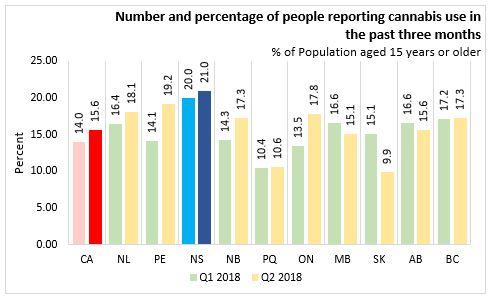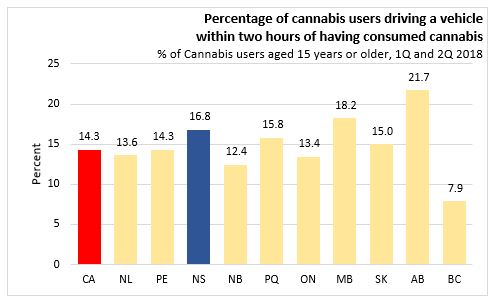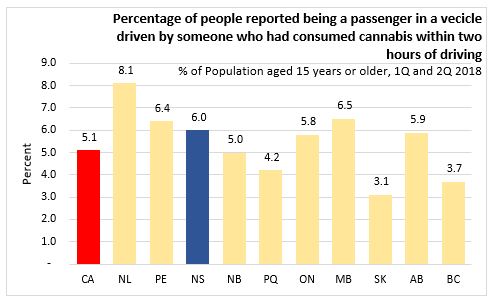The Economics and Statistics Division maintains archives of previous publications for accountability purposes, but makes no updates to keep these documents current with the latest data revisions from Statistics Canada. As a result, information in older documents may not be accurate. Please exercise caution when referring to older documents. For the latest information and historical data, please contact the individual listed to the right.
<--- Return to Archive
For additional information relating to this article, please contact:
August 09, 2018NATIONAL CANNABIS SURVEY, SECOND QUARTER 2018 To monitor cannabis consumption before and after the legislative change, Statistics Canada is conducting the National Cannabis Survey (NCS) every three months (quarterly) throughout 2018. This release provides the newest information about how cannabis use in Canada is changing, and includes information about its use as it relates to driving. New NCS data for the second quarter, collected from mid-May to mid-June, includes data for the provinces, as well as the territorial capitals.
CANNABIS USE
The second quarter National Cannabis Survey showed that about 4.6 million people nationally, or about 16% of Canadians aged 15 years or older, reported using cannabis in the prior three month period, similar to results from the first quarter of 2018. Twenty one per cent of Nova Scotians and 18 per cent of Ontarians reported using cannabis in the prior three months, above estimates for the rest of Canada. Over 19 per cent of the male population aged 15 and over reported use, compared to 12.2 per cent of females. The younger cohort, aged 15-24, reported 32.7 per cent of population having used cannabis in that period, compared to 13.2 per cent for the age group 25 and older.

Data from Q2 show that dried flower / leaf was the most popular (86%), followed by edibles (32%). Other products used by about 20 per cent of cannabis consumers included hashish and kief, liquid concentrates, and vape pens / cannabis oil cartridges. Higher percentages of males reported use of dried flower / leaf compared to females, who reported higher use of edibles.
DRIVERS AND PASSENGERS
This study contains data on cannabis use and on cannabis use and driving.
According to the most recent data collected over the first half of 2018, 14 per cent of cannabis users with a valid driver's icense reported driving within two hours of using cannabis. Males were nearly two times more likely than females to report this behaviour.
Nationally, using figures from the first and second quarter of 2018, 569,500 cannabis users reported driving a vehicle within two hours of having consumed cannabis, approximately 14.3 per cent of Canadian users 15 years or older. In Nova Scotia, this figure was 25,300, or 16.8 per cent of persons 15 years or older who were cannabis users (Note: This statistic has a wide confidence interval, meaning that 95 out of 100 times, the true figure in percentage terms could be as low as 10.3 per cent or as high as 26.3 per cent.). In percentage terms, Nova Scotia is the third highest among provinces, after Alberta (21.7%) and Manitoba (18.2%).

According to second quarter data, 5.1 per cent of Canadians (1.4 million) were passengers in vehicles operated by drivers who had consumed cannabis within the previous two hours. Youth and young adults aged 15.24 reported being passengers in vehicles by drivers who had consumed cannabis in the previous two hours more than twice as frequently as people aged 25 and over. In Nova Scotia, 43,600 people reported being passengers in such vehicles, about 6.0 per cent of the population (again, this statistic has a wide confidence interval, with a lower limit of 3.6% and an upper limit of 9.6%).

EXPENDITURES
Nationally, one third of cannabis users reported spending nothing on cannabis consumed during the second quarter, while another 25 per cent spent up to $100.00. Twenty one percent of users spent up to $250 and the same proportion spent more than $250. Frequency of use is a key determinant of expenditure amount, where higher spending was concentrated among more frequent users, and little or no spending among infrequent users.
SELF REPORTED EXPECTED BEHAVIOUR AFTER LEGALIZATION
Canadians were asked if they thought they would change their behaviour once the non-medical use of cannabis is legalized for adults. Eighty two per cent said they would be unlikely to try cannabis or increase consumption with legalization. Among current users, 28 per cent said they would be likely to increase use, while only 6 per cent of those not currently using indicated they would be likely to increase use.
These data are available from the Statistics Canada "National Cannabis Survey, second quarter 2018" publication. Other data are available on the StatsCannabis site.
<--- Return to Archive